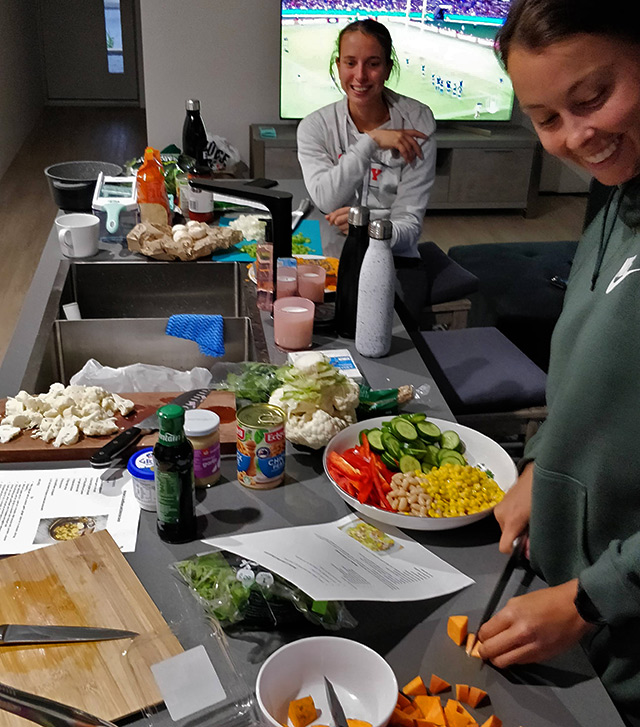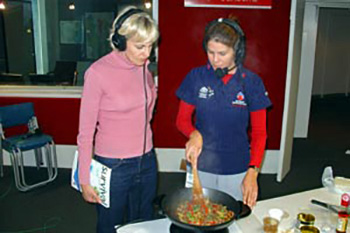- a guide for Sports Dietitians -
Just to make things clear, athough I conduct cooking classes, I am a sports dietitian not a 5-star chef! I certainly don't eat 5-star meals on a daily basis and I wouldn't expect my athletes to either. In fact, easy and quick cooking options, which are often more nutritious anyway, are better suited for an athlete's busy lifestyle. So you don't need to be a top chef to be able to teach athletes how to feed themselves - although it does help to have some cooking skills to enhance the athletes' experience!
 Athletes in a cooking class
Athletes in a cooking classWhy do it?
Nutrition is such an important part of an athlete's routine, and can absolutely have an impact on performance, so all athletes should know how to cook and be comfortable in the kitchen. This includes knowing not only how to wield a knife and chop onions, but also things like what flavours go well together, how to plan a weekly menu, along with what I consider the most important part: what nutrient balance is required for an athlete's sporting success. This is the great thing about cooking classes; it can be practical and lots of fun, while also a learning experience.
Many athletes go straight from living with parents, who do all the cooking and meal prep for them, to living on their own or with a teammate, often far away from parents, having to prepare all meals and snacks for themselves. Often they have no idea where to start. My first tip is always to encourage parents to get their junior athletes to help out in the kitchen and learn from them at home. This needs to happen before they move out and get thrown in the deep end on their own.
Target groups
You would certainly want to target your class to a group of athletes that are either in the same sport or team (e.g a professional footy team), are the same age and skill level (e.g. the junior development school-aged athletes), or have certain elements of their sport requiring similar fueling, (e.g. strength-based compared to endurance athletes).
Most of my classes have been with athletes who are members of a team as part of their role as professional athletes, and as such, this article is about these types of sessions. But classes could also be done with a random group of interested 'physically active' participants, after first advertising the type of class you are conducting and what the menu would be.
Having a specific sporting element, such as an endurance-athlete cooking class, will help with the planning of the menu for the session. Definitely get to know the groups' kitchen skill level before you start planning a menu, as this will allow you to aim the difficulty of the individual dishes to what they are capable of. It is no use trying to teach an athlete to make poached eggs if they have never even boiled one! Keep it at the right level.
Planning the session
Planning the menu is the most time consuming but most important part. What you choose to cook will depend, of course, on the group you are hosting. See some suggested menus. I often try to choose a variety of dishes, and ones that can be manipulated to suit the wide range of palates that athletes have. For example, if they are making a stir fry dish, you might offer four different types of vegetables, and they can choose their top three favorites for the dish itself. Doing a 3-course meal has worked really well for me in the past, as we will usually eat the dishes at the end of the session, and it is rather pleasant sitting down to a 3-course meal with dessert. Most people love a good dessert.
The dishes themselves need to be aimed at the skill level of the athletes or slightly more difficult so that it is a challenge for them, and they will learn some new skills at your session. Also, dishes that they may not have cooked before is always more interesting than ones they know. The idea of cooking education is to teach new things.
The menu plan needs to be able to be cooked without clashes in the kitchen. So for example you don't want to have three baked items that require different oven temperatures and times. Consider items that need to use different cooking methods, for example, one stovetop entrée, a baked main course, and a no-cook chilled dessert.
You also need to consider the date and time to lock in for the group. For professional athletes it is easy to schedule around their training time during the day, as they are full-time athletes. When it comes to non-professional athletes who work, or school-aged athletes, then evenings tend to be a better option. I often survey the athletes to find a date and time that suits the majority of the group.
A good location is also essential. A larger professional kitchen may be needed if you are hosting a larger number of athletes. However, for smaller groups, I will use my own kitchen (when the rest of the family is out) or one of the athletes' own kitchens can be an option too. I prefer working in smaller groups because it is easier to get more one-on-one teaching time. There are kitchen facilities out there for hire, just find a central location to suit, and be sure to book in advance. Finding out what specific facilities the kitchen has is also a great idea, so you can plan the menu accordingly.
Shopping
I have done this in several different ways, again depending on the group you are working with and the type of skill you want to impart to them. For younger or less experienced attendees, I would do the shopping myself just before the session so the food is as fresh as possible. For older or more experienced attendees, you could incorporate the shopping as an extra session for learning, and do it the day before, or do one longer session to incorporate both. I do prefer to conduct a shopping tour at a separate time though, including a lot of education around label reading, which means you are not asking athletes to commit a long time to complete the session.
 Clare on the radio demonstrating a recipe
Clare on the radio demonstrating a recipeHow the session runs
Depending on the number of attendees you have, you might plan for one dish per 2-3 people. This will depend on how large the group is. For example; 2 people per dish for smaller groups of 6, and 3 people per dish for larger groups of 9+. If there is an odd number, allocate the extra person as a floater or to a dish that is more challenging and has more steps in the method.
On arrival, I would usually place the set of ingredients for each dish on a bench space. I would then proceed to disclose the dishes that the participants are cooking, along with the recipe. Let them choose which they would like to do, unless you choose to do the same dish for all. I like to have different dishes, because even if at the end of the class, participants have only cooked one of the dishes, they can at least try the others to taste, and then they can aim to repeat it later if they like it.
Float around each group to assist or answer any questions. I like to use opportunities for questions to inform the whole group, or to discuss a particular nutrition topic that may be of interest or have some confusion attached to it. It is surprising how much conversation is stimulated when people are chopping and cutting.
Things to cover
My aim for a cooking class is to teach athletes as much as I can, without overwhelming them. It's not all about the cooking, but including some or all of the information below can be worked into the time you have with the group:
- Basic knife skills (I am always surprised how often I get asked how to cut up a particular vegetable).
- Other cooking skills around methods and timing.
- Information about different utensils, apparatus, pot and pan uses.
- Food safety and hygiene like using separate chopping boards for cutting up different food items.
- And of course nutrition, and more specifically sports nutrition!
At the end of each session, always get participants to at least try the food that has been cooked. I usually aim for the timing to be finished together, so we can eat sitting down as a group and enjoy the food we have made. I always give copies of the recipes at the end of the session to take away with them. This used to be a paper version, but more recently I've shifted to sending electronic versions so as to not get lost or messed up with food spills.
It is often joked about during a session about who is doing the washing up! I always make this clear from the beginning - wash what you can as you go, and each mini-group is to clean up after themselves.
Possible issues
If a session is well planned hopefully not much can go wrong. However, even the best-laid plans can take a turn.
- Certainly checking what facilities and equipment are available so you don't make the mistake of not having what you need on the day. Save the embarrassment of turning up with food for 'spiral zucchini noodles' and there is no spiraller to use.
- If no one likes the dishes you have planned, then having some more flexible options like the ability to change the sauce or vegetables in a particular dish may help alleviate this issue.
- Be sure to ascertain any allergies first, so you don't have a potential situation of allergic reaction on your hands. Plan the menu around this. Maybe even plan a menu for allergen-free options, if you have a few people with the same allergy.
- Stay on top of the clean-up, as there can be a large mess at the end if you don't.
Related Pages
- Cooking Class Example Menus
- Sports Chef — providing tasty meals that are also good for the athlete.
- How to Conduct a Shopping Tour for Athletes
- More Resources for Sports Dietitians
- Athlete Recipes
- List of Cookbooks for Athletes
- Sports nutrition home


 Current Events
Current Events